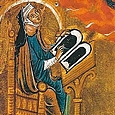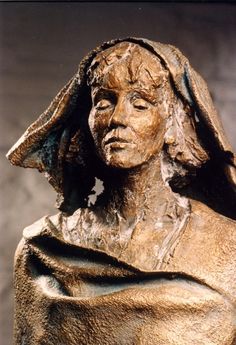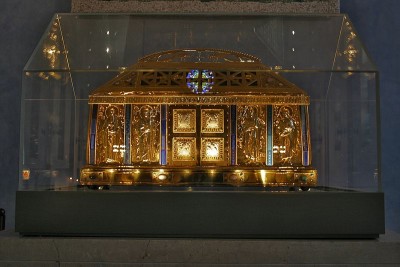
Summary: Hildegard of Bingen, (1098–1179), a German mystic, writer, composer, philosopher, Benedictine abbess, visionary, & polymath. “Who is this woman?” asked Cistercian Pope Eugenius III, when shown her writings. “She rises out of the wilderness like a column of smoke from burning spices.”
 Hildegard had a big influence in her own day but was wiped out from Church consciousness for eight centuries, in recent years she has made a big comeback through feminism, and creation/ environmental theology. The central theme of her writings is the life-giving power of God – what she called “the beauty of greenness“ (pulchritudo viriditatis). There is also much recent interest in her music and poetry.
Hildegard had a big influence in her own day but was wiped out from Church consciousness for eight centuries, in recent years she has made a big comeback through feminism, and creation/ environmental theology. The central theme of her writings is the life-giving power of God – what she called “the beauty of greenness“ (pulchritudo viriditatis). There is also much recent interest in her music and poetry.
Patrick Duffy profiles this extraordinary medieval lady.
Childhood at Bermerstein and her formation
Born in 1098, the tenth child of noble parents Hildebert and Mechtild at Bermersheim near Mainz in the Rhineland, Hildegard was educated at the Benedictine cloister of Disibodenberg by Jutta von Spanheim and succeeded her as abbess when she died in 1136.
Visions
 From the age of three she had experienced visions accompanied by headaches. On reporting them to her confessor, he encouraged her to write them down, and the headaches disappeared. Her confessor showed what she had written to the archbishop of Mainz, who appointed a monk named Volmar to be her secretary.
From the age of three she had experienced visions accompanied by headaches. On reporting them to her confessor, he encouraged her to write them down, and the headaches disappeared. Her confessor showed what she had written to the archbishop of Mainz, who appointed a monk named Volmar to be her secretary.
The Scivias
The archbishop showed the resulting work Scivias (short for Scito vias Domini = “Know the ways of the Lord” 1142-52) to the Cistercian Pope Eugenius III, then visiting Trier. “Who is this woman?“ he asked when he read it. “She rises out of the wilderness like a column of smoke from burning spices.” The book contains 26 visions about the Church, the relationship between God and man and redemption. It is a theology, telling the history of salvation centred on Jesus from creation to the Second Coming.
Her convent at Rupertsberg
Around 1147 Hildegard – possibly to secure a more independent role for herself and her sisters – left Disibodenberg and set up a convent in Rupertsberg near Bingen on the Rhine. The move caused a rift with the abbot and monks of the monastery of St Disibod – because of the feared loss of revenue – and stress to Hildegard, but within a few years she had a thriving community of fifty nuns.
Knowledge of Medicine
Hildegard cared for the sick nuns of her own community and from this experience she wrote two books on medicine. It describes herbal remedies and the circulation of the blood five centuries before the scientist Harvey.
Poetry, Music and the Arts
A gifted poet and musician, she also produced hymns and canticles for her nuns to sing. These have recently been reproduced and are currently popular sales items. She also installed a piped-water system in her convent. She made illustrations for the Scivias and devised an early form of an international language like Esperanto.
Convent Under Interdict
Hildegard came into conflict with the archbishop of Mainz when she took a decision to bury in the convent cemetery the body of a young nobleman, who had been excommunicated. She knew that the man had repented before he died and she had acted in good conscience. The archbishop put her monastery under’ interdict’ thus depriving the community of the sacraments for some months and forbidding music in their church. Hildegard’s response was to write a long letter to the bishop on sacred music to which she added:
“Those therefore who, without good reason, impose silence on churches in which singing in God’s honour can be heard will not deserve to hear the glorious choirs of angels praising the Lord in heaven.”
The archbishop lifted the interdict.
When she was about sixty, she devoted five years going around actively preaching and teaching and speaking to all kinds of people.
Death and Influence
Active to the last, Hildegard died on 17 September 1179. Though many miracles were reported during her life and at her tomb, she was never formally canonised, but she is listed as a saint for that day in the Roman Martyrology.

Hildegard’s Relics
_____________________________________
******************************
Memorable Sayings for Today
Green is the prime colour of the world,
and that from which its loveliness arises.”
– Pedro Calderon de la Barca –
“The future will either be green or not at all.”
– Bob Brown –
******************************